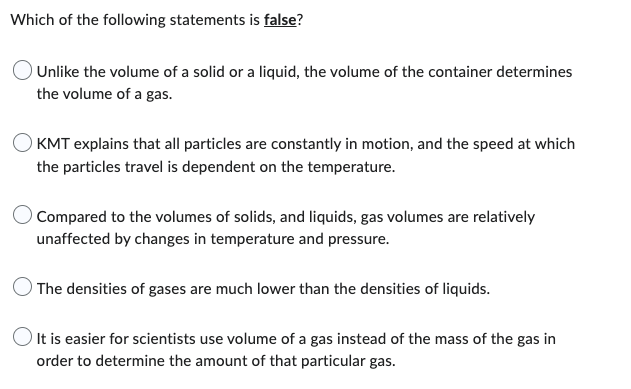Which of the following statements is false? Unlike the volume of a solid or a liquid, the volume of the container determines the volume of a gas. KMT explains that all particles are constantly in motion, and the speed at which the particles travel is dependent on the temperature. Compared to the volumes of solids, and liquids, gas volumes are relatively unaffected by changes in temperature and pressure. The densities of gases are much lower than the densities of liquids. It is easier for scientists use volume of a gas instead of the mass of the gas in order to determine the amount of that particular gas.
Which of the following statements is false? Unlike the volume of a solid or a liquid, the volume of the container determines the volume of a gas. KMT explains that all particles are constantly in motion, and the speed at which the particles travel is dependent on the temperature. Compared to the volumes of solids, and liquids, gas volumes are relatively unaffected by changes in temperature and pressure. The densities of gases are much lower than the densities of liquids. It is easier for scientists use volume of a gas instead of the mass of the gas in order to determine the amount of that particular gas.
Chapter5: Gases
Section: Chapter Questions
Problem 143CWP: A certain flexible weather balloon contains helium gas at a volume of 855 L. Initially, the balloon...
Related questions
Question

Transcribed Image Text:Which of the following statements is false?
Unlike the volume of a solid or a liquid, the volume of the container determines
the volume of a gas.
KMT explains that all particles are constantly in motion, and the speed at which
the particles travel is dependent on the temperature.
Compared to the volumes of solids, and liquids, gas volumes are relatively
unaffected by changes in temperature and pressure.
The densities of gases are much lower than the densities of liquids.
It is easier for scientists use volume of a gas instead of the mass of the gas in
order to determine the amount of that particular gas.
Expert Solution
This question has been solved!
Explore an expertly crafted, step-by-step solution for a thorough understanding of key concepts.
Step by step
Solved in 2 steps

Knowledge Booster
Learn more about
Need a deep-dive on the concept behind this application? Look no further. Learn more about this topic, chemistry and related others by exploring similar questions and additional content below.Recommended textbooks for you


Physical Chemistry
Chemistry
ISBN:
9781133958437
Author:
Ball, David W. (david Warren), BAER, Tomas
Publisher:
Wadsworth Cengage Learning,

Chemistry
Chemistry
ISBN:
9781305957404
Author:
Steven S. Zumdahl, Susan A. Zumdahl, Donald J. DeCoste
Publisher:
Cengage Learning


Physical Chemistry
Chemistry
ISBN:
9781133958437
Author:
Ball, David W. (david Warren), BAER, Tomas
Publisher:
Wadsworth Cengage Learning,

Chemistry
Chemistry
ISBN:
9781305957404
Author:
Steven S. Zumdahl, Susan A. Zumdahl, Donald J. DeCoste
Publisher:
Cengage Learning

Chemistry: An Atoms First Approach
Chemistry
ISBN:
9781305079243
Author:
Steven S. Zumdahl, Susan A. Zumdahl
Publisher:
Cengage Learning

Introductory Chemistry: A Foundation
Chemistry
ISBN:
9781337399425
Author:
Steven S. Zumdahl, Donald J. DeCoste
Publisher:
Cengage Learning

Introductory Chemistry: An Active Learning Approa…
Chemistry
ISBN:
9781305079250
Author:
Mark S. Cracolice, Ed Peters
Publisher:
Cengage Learning